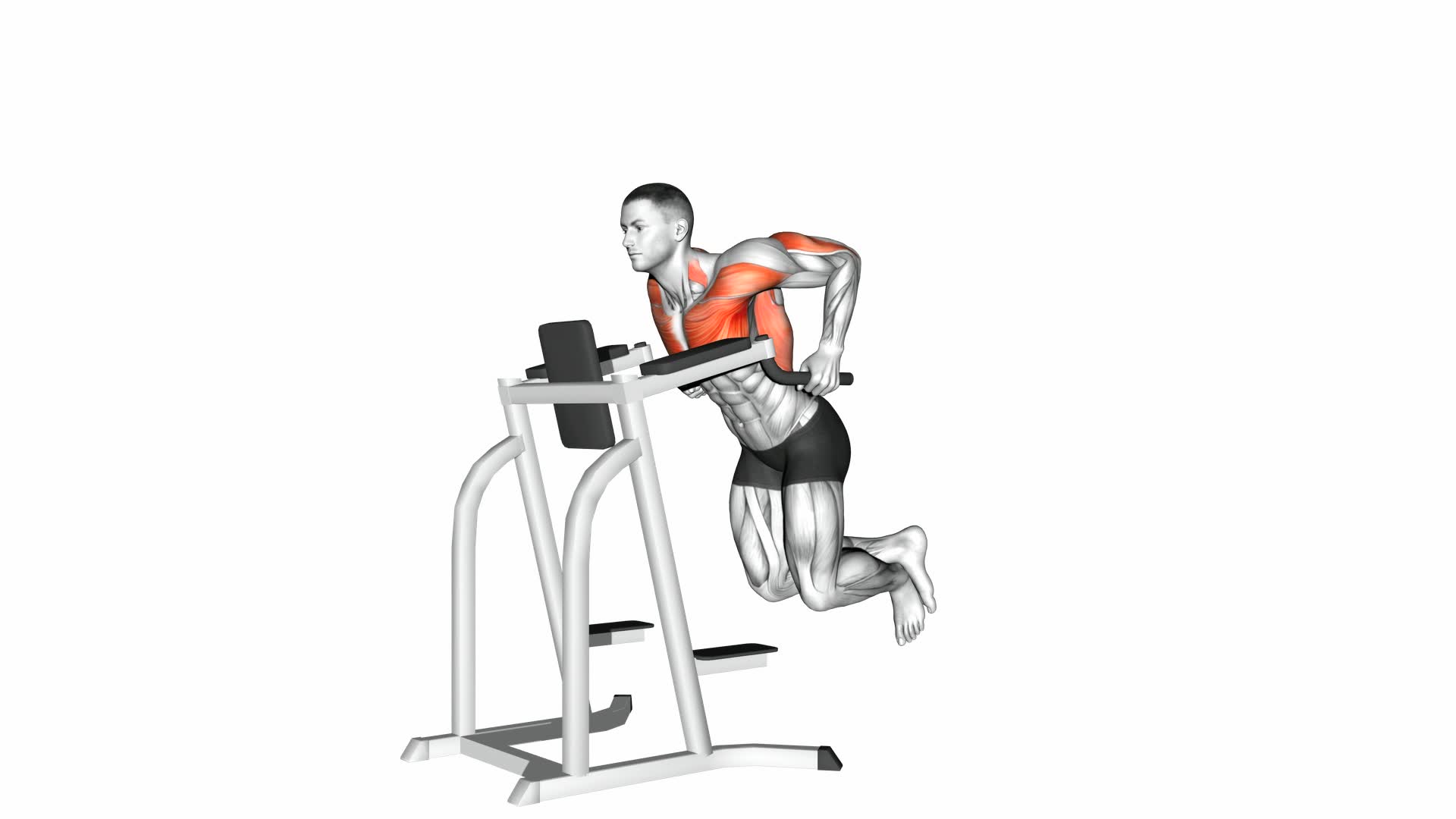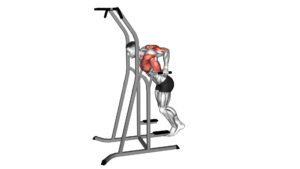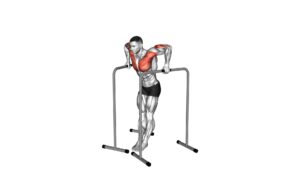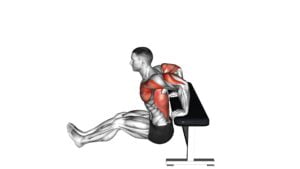Chest Dip – Video Exercise Guide & Tips

Are you looking to strengthen your chest muscles and improve your upper body strength? Look no further than chest dips!
Watch This Exercise Video
This video exercise guide will show you the proper technique and form, along with variations and progressions to keep challenging yourself.
Learn the benefits of incorporating chest dips into your workout routine and discover common mistakes to avoid.
Follow these tips to maximize your results and take your fitness to the next level.
Key Takeaways
- Proper technique and form are essential for performing chest dips effectively and safely.
- Chest dips engage multiple muscle groups, including the pectoralis major and minor, triceps, and shoulders.
- Alternative exercises, such as resistance bands or bench dips, can be used if a dip station is not available.
- Variations and progressions, such as adding weight or incorporating plyometric movements, can increase the intensity and effectiveness of chest dips.
Proper Technique and Form
To perform the chest dip exercise correctly, start by positioning yourself between parallel bars. This exercise is effective for targeting your chest muscles, triceps, and shoulders. It's important to maintain proper technique and form to avoid common injuries and maximize results.
Before starting, make sure you have the necessary equipment. You'll need parallel bars, which can be found at most gyms or purchased for home use. Ensure that the bars are stable and secure before attempting the exercise.
To begin, grip the bars with your palms facing down and your arms fully extended. Lean forward slightly and cross your legs at the ankles. Lower your body by bending your elbows and keeping them close to your sides. Go down until your shoulders are slightly below your elbows.
Remember to keep your core engaged and your back straight throughout the exercise. Avoid swinging your body or using momentum to lift yourself back up. Focus on using your chest muscles to push yourself back to the starting position.
Benefits of Chest Dips
Chest dips offer a range of benefits for your upper body strength and muscle development. When you perform chest dips, you engage multiple muscle groups simultaneously, including the chest, triceps, shoulders, and even the core muscles. This compound exercise helps to build upper body strength and improve overall muscle tone.
One of the key benefits of chest dips is that they target the chest muscles, specifically the pectoralis major and minor. By adding this exercise to your routine, you can effectively develop and strengthen your chest muscles, leading to a more defined and sculpted upper body.
In addition to targeting the chest muscles, chest dips also engage the triceps. This exercise places a significant amount of tension on the triceps, helping to improve their strength and size. Strong triceps not only enhance the overall appearance of your arms but also contribute to better performance in pushing and pressing movements.
Furthermore, chest dips engage the shoulder muscles, including the deltoids, during the movement. This helps to improve shoulder stability and strength, which is crucial for various upper body exercises and daily activities.
If you're looking for chest dip alternatives, you can try using resistance bands or performing bench dips. Resistance bands provide a similar movement pattern and can be a great alternative if you don't have access to a dip station. Bench dips, on the other hand, target similar muscle groups but with a slightly different angle.
Variations and Progressions
Now let's delve into different ways you can vary and progress your chest dip exercises.
If you're looking to challenge yourself and take your chest dips to the next level, there are a few advanced techniques you can incorporate. One option is to add weight to your dips by using a weighted vest or holding a dumbbell between your feet. This increases the resistance and forces your muscles to work harder, leading to greater muscle activation and strength gains.
Another way to progress your chest dips is by performing them on gymnastic rings instead of parallel bars. This unstable surface adds an extra level of difficulty and requires greater stability and control from your muscles. It also engages more muscles in your upper body, including your core and shoulder stabilizers.
To further intensify your chest dips, you can try incorporating plyometric variations. This involves explosively pushing yourself up from the bottom position and then quickly lowering yourself back down. Plyometric chest dips increase the power and speed of your movements, helping to enhance your athletic performance.
Remember to always prioritize proper form and technique when attempting these advanced techniques. Start with lighter weights or progressions and gradually increase the difficulty as you become more comfortable and strong. This will ensure you get the most out of your chest dip exercises while minimizing the risk of injury.
Common Mistakes to Avoid
When performing chest dips, it's important to be aware of common mistakes that can hinder your progress and potentially lead to injury. To ensure you're getting the most out of this exercise and avoiding any potential pitfalls, here are some common mistakes to avoid:
- Dropping too low: It may be tempting to go as low as possible during a chest dip, but this can put excessive strain on your shoulders and increase the risk of injury. Instead, aim to lower yourself until your upper arms are parallel to the ground.
- Flaring your elbows: Allowing your elbows to flare out to the sides during a chest dip can shift the focus away from your chest and onto your triceps. Keep your elbows tucked in close to your sides to target your chest muscles effectively.
- Neglecting proper technique: It's crucial to maintain proper technique throughout the exercise. Avoid swinging your body or using momentum to complete the movement. Instead, focus on controlled and smooth movements, engaging your chest muscles throughout the entire range of motion.
By being mindful of these common mistakes and focusing on proper technique, you can maximize the benefits of chest dips while minimizing the risk of injury.
Keep these tips in mind and strive for excellence in your chest dip workouts.
Tips for Maximizing Results
To maximize your results, focus on incorporating proper form and gradually increasing the intensity of your chest dip workouts.
Proper form is crucial to target the chest muscles effectively and prevent injuries. Start by positioning yourself on parallel bars with your arms fully extended and your feet off the ground. Lower your body by bending your arms until your shoulders are below your elbows. Pause for a moment, then push yourself back up to the starting position. Remember to keep your elbows pointed outwards and your core engaged throughout the exercise.
Incorporating chest dips into your workout routine can greatly contribute to maximizing muscle growth. By adding variety to your chest exercises, you can challenge your muscles in different ways and promote overall development.
To get the most out of your chest dip workouts, consider adding weight by using a dip belt or weighted vest. Start with a weight that allows you to perform 8-12 reps with proper form and gradually increase the weight as you get stronger.
Additionally, it's important to listen to your body and give yourself enough time to recover between workouts. Overtraining can hinder your progress and increase the risk of injury. Aim to perform chest dips 2-3 times a week, allowing at least 48 hours of rest between sessions.
Frequently Asked Questions
How Often Should I Incorporate Chest Dips Into My Workout Routine?
To maximize the benefits of chest dips, it's important to incorporate them into your workout routine regularly. By targeting your chest muscles, chest dips help to build strength and definition.
The frequency of incorporating chest dips will depend on your overall fitness goals and current level of strength. It's recommended to start with 2-3 sets of chest dips per week and gradually increase as you become more comfortable.
Experiment with different variations, such as weighted chest dips or close-grip chest dips, to challenge your muscles in new ways.
Can Chest Dips Help Improve My Upper Body Strength and Muscle Definition?
Chest dips are an excellent exercise for improving your upper body strength and muscle definition. By incorporating chest dips into your workout routine, you can expect to see significant gains in your upper body strength and noticeable improvements in muscle definition.
This exercise specifically targets your chest, shoulders, and triceps, helping to build lean muscle and increase overall upper body strength. Consistency and proper form are key to achieving optimal results.
Are There Any Alternative Exercises I Can Do if I Don't Have Access to a Dip Bar?
If you don't have access to a dip bar, there are alternative exercises you can do to work your upper body.
One option is to perform bench dips using a sturdy chair or bench.
Another option is to do push-ups, which target the chest, shoulders, and triceps.
You can also try using resistance bands to simulate the movement of a dip.
These modifications will help you strengthen and define your upper body without a dip bar.
Should I Be Concerned About Any Potential Injuries or Strain on My Shoulders When Performing Chest Dips?
When performing chest dips, it's important to be mindful of potential shoulder strain or injuries. You should always prioritize proper form and technique to minimize the risk.
Start by warming up your shoulders and gradually increase the intensity of your workouts. Listen to your body and avoid pushing beyond your limits.
If you experience any discomfort or pain in your shoulders, it's best to consult a professional to prevent further injury. Remember, safety should always be your top priority.
Can Chest Dips Be Beneficial for Both Men and Women, or Are They More Suitable for One Gender Over the Other?
Chest dips are a great exercise for both men and women. They offer numerous benefits for women, such as toning the chest muscles and improving upper body strength.
Additionally, chest dips can be adapted to different fitness levels by using variations like assisted dips or weighted dips. Whether you're a beginner or an advanced fitness enthusiast, chest dips can help you achieve your goals and strengthen your upper body.
Conclusion
In conclusion, chest dips are an effective exercise for targeting the chest muscles and building upper body strength. By maintaining proper technique and form, individuals can maximize the benefits of this exercise.
Additionally, incorporating variations and progressions can help to continuously challenge and improve muscle growth. It's important to avoid common mistakes and follow the tips provided in order to achieve the best results from chest dips.

Author
Years ago, the spark of my life’s passion ignited in my mind the moment I stepped into the local gym for the first time. The inaugural bead of perspiration, the initial endeavor, the very first surge of endorphins, and a sense of pride that washed over me post-workout marked the beginning of my deep-seated interest in strength sports, fitness, and sports nutrition. This very curiosity blossomed rapidly into a profound fascination, propelling me to earn a Master’s degree in Physical Education from the Academy of Physical Education in Krakow, followed by a Sports Manager diploma from the Jagiellonian University. My journey of growth led me to gain more specialized qualifications, such as being a certified personal trainer with a focus on sports dietetics, a lifeguard, and an instructor for wellness and corrective gymnastics. Theoretical knowledge paired seamlessly with practical experience, reinforcing my belief that the transformation of individuals under my guidance was also a reflection of my personal growth. This belief holds true even today. Each day, I strive to push the boundaries and explore new realms. These realms gently elevate me to greater heights. The unique combination of passion for my field and the continuous quest for growth fuels my drive to break new ground.







